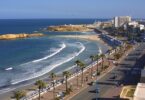Blood continues to spill in Tijuana and and other border-area communities.
And the debate rages on as to whether it’s safe for surfers, campers, fishermen and other tourists to travel in northern Baja California.
First, the latest grim news: Nine human heads were found Sunday in Tijuana, along with a note tying the massacre to the ongoing war between rival drug gangs.
A day later, a report emerged describing November as the deadliest month during President Felipe Calderon’s two years in office, with at least 701 killings linked to organized crime occurring throughout Mexico.
Tourists, by and large, have not been victimized.
Now for two voices on the issue of safety in northern Baja:
Serge Dedina, executive director of the conservation group Wildcoast, in an editorial for Voice of San Diego, recalled the recent death of a cousin of one of his Wildcoast colleagues.
The woman was caught in the crossfire “of a narco massacre at a roadside restaurant” in El Rosario, a fishing and agricultural village south of Ensenada. The woman’s two children were witness to an ambush that also killed three other diners.
Dedina, who advises against travel into northern Baja, stated: “There are four things to be concerned with: 1) Getting caught in the crossfire of a narco firefight; 2) Being robbed by narco gunmen; 3) Being robbed by corrupt police officers; and 4) Being robbed by drug addicts and criminals in urban areas and more remote areas of the peninsula once perceived to be very safe.”
Dedina, a surfer who spends lots of time much farther south on the Baja peninsula, asked, “Do you really need to eat overpriced fish tacos in Tijuana or Rosarito Beach?”
Not related to Dedina’s editorial was a letter last week by Jim Gerber, director of the Center for Latin American Studies at San Diego State University, addressed to students and faculty, pertaining specifically to travel into Tijuana, and to a U.S. State Department travel alert issued recently and spread around campus.
Gerber called the drug wars “real” and urged anyone traveling into Tijuana “to exercise the same caution that they exercise when in any major city.” Gerber, however, assured that the violence “has been going on for several years” and that the travel alert is merely “a re-issuance of an alert that has been in place for some years.”
Gerber stated that the murder rate in Tijuana is less than 40 per 100,000, or between that of Oakland and St. Louis. “That is high, but less than Baltimore and Detroit (mid-40s) and well below New Orleans (65 to 95, depending on who you talk to).”
Gerber continued, “New Orleans is a great place to visit, and we have yet to meet anyone who decided not to go due to its murder rate.”
Gerber further declared that the violence is between drug gangs and police fighting the drug wars and that life goes on in Tijuana. “We do not want to minimize the reality of the drug wars,” Gerber wrote. “But we also want to point out that, as with our war on terror, paranoia grows in proportion to one’s lack of familiarity and understanding.
“We thus caution against allowing fear to manifest in perceived narratives of racism and morality as has occurred far too often in interactions between the United States and Mexico.”
Gerber may be a bit late with his cautionary plea, as for many prospective Baja travelers the manifestations of fear have already grabbed deep root.





















